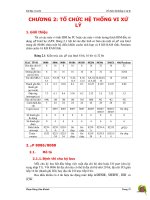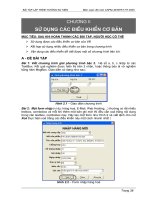Chuong 2 ssh(p19)
Bạn đang xem bản rút gọn của tài liệu. Xem và tải ngay bản đầy đủ của tài liệu tại đây (566.87 KB, 54 trang )
Application Layer
Protocols 2
Today's objectives
More on FSMs
aggregate state machine
checking properties
More application-layer protocols
remote login
quick introduction to security
ssh: secure shell
peer-to-peer networks
2
Application layer
Host
Router
Host
Application
Application
Transport
Transport
Network
Link/Physical
Network
L/P
L/P
Network
Link/Physical
3
Intersection server FSM #1
RED
rcv_msg (cl, RED)
------------------------------send_msg ([NSEW \ cl],
ALL_RED)
rcv_msg(cl, NEED_GREEN)
--------------------------------send_msg (cl, OK_GREEN)
ONE_GREEN
rcv_msg(cl, NEED_GREEN)
---------------------------------
4
Intersection client FSM #1
from_detector (car waiting)
--------------------------------------send_msg(server, NEED_GREEN)
RED
CAR_WAITING
timer expires
------------------------------set_light (red)
send_msg (server, RED)
GREEN
rcv_msg(OK_GREEN)
--------------------------------set_timer (20sec)
set_light (set green)
5
Joint FSM
Joint FSM:
An FSM that captures the evolution of the system as a whole
Each state S of the joint FSM corresponds to the set of states
each component FSM 1,...,n is in:
S=(S1,S2,...,Sn)
Every transition (S1,S2,...,Sn) -> (S1',S2',...,Sn') corresponds
to one or several transitions in component FSMs
If several transitions, they have to be concurrent
6
Joint FSM for intersection protocol #1
State = (server, state_client1, state_client2)
(OG,
R,CW)
(R,
R,CW)
(R,
CW,R)
(OG,
CW,R)
(R,
R,R)
(OG,
R,G)
(OG,
CW,CW)
(OG,
CW,G)
(OG,
R,R)
(OG,
R,R)
(R,
CW,CW)
(OG,
CW,R)
(R,
CW,R)
(R,
CW,CW)
(R,
R,CW)
(OG,
G,R)
(OG,
CW,CW)
(OG,
R,CW)
(OG,
G,CW)
7
Joint FSM for intersection protocol #1
(OG,
R,CW)
(R,
R,CW)
(R,
CW,R)
(OG,
CW,R)
(R,
R,R)
(OG,
R,G)
(OG,
CW,CW)
(OG,
CW,G)
(OG,
R,R)
(OG,
R,R)
(R,
CW,CW)
(OG,
CW,R)
(R,
CW,R)
(R,
CW,CW)
(R,
R,CW)
(OG,
G,R)
(OG,
CW,CW)
(OG,
R,CW)
(OG,
G,CW)
8
Joint FSM for intersection protocol #1
Classes of states
We can leave class 1 to either class 2 or 3 and never come
back!
Class 1
Class 2
Class 3
9
Intersection client FSM #2, no blocking
from_detector (car waiting)
--------------------------------------send_msg(server, NEED_GREEN)
RED
CAR_WAITING
timer expires
------------------------------set_light (red)
send_msg (server, RED)
GREEN
rcv_msg (ALL_RED)
--------------------------------------send_msg(server, NEED_GREEN)
rcv_msg(OK_GREEN)
--------------------------------set_timer (20sec)
set_light (set green)
10
Joint FSM for intersection protocol #2
State = (server, state_client1, state_client2)
(OG,
R,CW)
(R,
R,CW)
(R,
CW,R)
(OG,
CW,R)
(R,
R,R)
(OG,
R,G)
(OG,
R,R)
(OG,
CW,CW)
(OG,
CW,G)
srv: rcv(cl2, NEED_GREEN)
-------------------------------------srv: send(cl2, OK_GREEN)
(R,
CW,CW)
(OG,
CW,R)
(R,
CW,R)
(OG,
R,R)
(R,
cl2: rcv(ALL_RED)
CW,CW)
--------------------------------------cl2: send(srv,NEED_GREEN)
(R,
R,CW)
(OG,
R,CW)
(OG,
G,R)
(OG,
CW,CW)
(OG,
G,CW)
11
Joint FSM for intersection protocol #2
Single class of states
We can go from anywhere to anywhere, given the right “input”
Class 1
12
Another example of FSM-based analysis
condition C
----------------action D
condition A
----------------action B
X
condition C
----------------action D
Y
condition A
----------------action B
is equivalent to:
condition A
----------------action B
Z
condition C
----------------action D
All that matters is input->output
Can we get rid of internal states?
Automatic simplification
13
FSM: summary
Individual FSM:
Describes individual protocol entity
Joint FSM:
Can be generated automatically
Describes communicating set of entities
Protocol verification: check properties such as “no absorbing
classes of states”; if such a class exists, what is sequence of
events that leads there, etc.
Advantage:
Allows mathematical proof of these properties
Software tools, code generators
Disadvantage:
Computational complexity quickly becomes large as FSMs
become more complex -> number of joint states explodes
14
Remote session: telnet, rlogin, ssh
Work on a remote system
Applications
telnet
R-commands of Unix
rlogin, rsh, rcp
ssh
Principles
send characters typed on the keyboard to the remote
shell
receive characters from the remote shell and display
15
rlogin, telnet, ssh
t eln et
clien t
t er m in al
dr iver
user
t eln et
ser ver
TCP/ IP
TCP/ IP
pseudo
t er m in al
dr iver
sh ell
16
rlogin
Connection between UNIX systems
port 513
Authentication
password (send in clear)
.rhosts file
host name
user name
Typed character
echo sent by the remote system
17
telnet
Connection between any system
NVT (Network Virtual Terminal)
common denominator between different systems
NVT ASCII
–
–
Port 23
Options
7 b i t s , en d of l i n e: CR, LF
al s o u s ed b y FTP, SMTP, f i n ger , w h oi s , HTTP
character mode, line mode
Escape - interpreted by the client
Control-]
18
SSH: what is network security?
Confidentiality: only sender, intended receiver
should “understand” message contents
sender encrypts message
receiver decrypts message
Authentication: sender, receiver want to confirm
identity of each other
Message Integrity: sender, receiver want to
ensure message not altered (in transit, or
afterwards) without detection
Access and Availability: services must be
accessible and available to users
19
Friends and enemies: Alice, Bob, Trudy
Well-known in network security world
Bob, Alice want to communicate “securely”
Trudy (intruder) may intercept, delete, add
messages
Bob
Alice
ch an n el dat a, con t r ol
m es s ages
dat a
secur e
sen der
secur e
r eceiver
dat a
Tr udy
20









